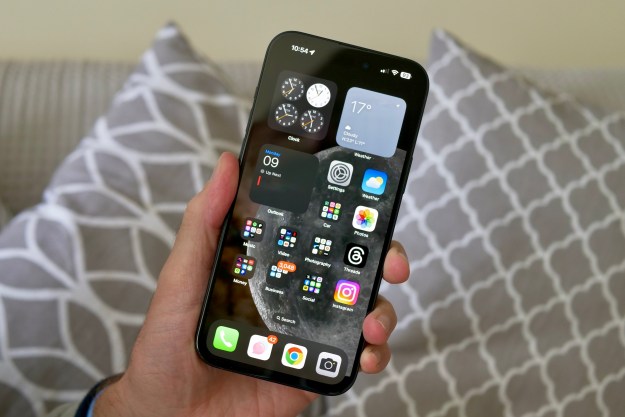“When compared to the Sidekick II, this device has tons of improvements in all departments except the camera.”
- Stylish design; easy-to-use GUI and menu; trackball works great; EDGE compatible
- Bluetooth is not 2.0; bad camera; poor battery life
Summary
Both celebrities and consumers have indulged themselves in T-Mobile’s Sidekick. The personal communication device is perfect for keeping in touch with friends, as well as e-mail and web browsing. Although the Sidekick II was immensely popular, it was lacking some much-needed features such as Bluetooth and EDGE. With the introduction of T-Mobile’s Sidekick 3 in July, many of these problems and missing features will be addressed. The device offers plenty of features that are bound to keep users happy.
This new version of the Sidekick has obviously gotten a facelift. From the sleek black design and thinner width to the smaller buttons and trackball, users will feel like they’re on a more professional device, as opposed to a toy. Buttons are smaller and are easier to use, plus the trackball makes navigation quicker and easier.
The Danger-based OS the Sidekick 3 uses is not that different than the Sidekick II’s. It’s still easy to use and now features a music player application for playing MP3 files. Using the included headphones and USB cable, loading music onto your Sidekick 3 is as easy as dragging and dropping music files on the phone.
Those fed up with not being able to carry an extra battery will be ecstatic over the new removable battery. Removing the battery reveals an easy to reach SIM-card slot and mini-SD card slot. You don’t have to remove the battery to access the SD card though, which is a great design feature. Also, Bluetooth 1.2 is included for use with headsets. Although version 2.0 would have been better, most people will just be glad they can use a wireless headset with their Sidekick now.
Anyone who was hoping the 1.3 megapixel camera on the Sidekick 3 would be a vast improvement over its predecessor is in for disappointment. The camera is technically better than the Sidekick II’s, but the picture quality is still absolutely horrible and isn’t even very good for viewing on phone screens. The fact that Sharp has the nerve to say they included a 1.3 megapixel camera in this phone means that they either exaggerated the camera’s picture quality or they just made a horrible camera. Don’t plan on taking too many pictures with the Sidekick 3.
A decent screen is included and works great for your chatting, texting, and e-mailing. Viewing photos on it isn’t incredibly impressive, but it’s not terrible either. The keyboard included feels sturdy and is great for fast typing. It’s about the same as the Sidekick II’s and works better than any Blackberry out there. So don’t worry at all about sending long messages.
The price point may be a bit high for some, though, with the device costing $400 outright or $300 with contract upgrades.
Image Courtesy of T-Mobile
Unpacking the Sidekick 3 is nice and simple. Pop in the battery and start charging it. If you want, throw in the included mini-SD card so you can leave your iPod at home. Tunes sound great on the included headphones and there are dedicated volume buttons for easy adjustment. Using the music player is also designed to be extremely easy to use and has no lag when changing songs.
If you want to make a call, just select the “Phone” option and start dialing. Calls sound pretty decent on the phone and there is a virtual keypad for dialing without revealing the keyboard. Unfortunately, you’re still going to be getting Sidekick-based reception. Mediocre is the name of the game, so you’ll find yourself ducking in and out of rooms to produce a signal. Sharp really should have done more research and put more effort into producing a decent antenna to use, since the device is pretty much a brick without a signal.
The IM client is no longer limited to AOL Instant Messenger and now includes a Yahoo! and MSN login option. Using it is easy and is the same as the Sidekick II in almost every aspect. It’s a well-built client that doesn’t really need a ton of changes. It’s always nice to be able to keep in touch with friends and an IM client that supports multiple services is always welcome on a device like this.
E-mailing is simple and supports multiple accounts so you can get your Gmail and Hotmail all in one place without having to worry. E-mails tend to send and receive more quickly due to the EDGE capability of T-Mobile’s network. IMAP and POP are both supported, so any service should be easy to set up, unless you’re some kind of security freak.
Finally, browsing the web is always fun, so those wanting to do so should grab a Sidekick 3. It’s quick and easy to use with plenty of shortcuts built in for better navigation. However, because the Sidekick 3 includes a trackball, horizontal scrolling would have been possible and could have allowed webpages to be displayed without the need to be resized for the Sidekick’s screen. Still, this device does a decent job of letting users visit their favorite websites (although you still can’t login and use MySpace properly – sorry, to all you teenagers out there).




When compared to the Sidekick II, this device has tons of improvements in all departments except the camera. Bluetooth alone is a selling point to get users to upgrade, as well as the included music player. Increased speed with the EDGE network is a nice feature that makes IMing and web browsing better, but it’s not the only device on the market with EDGE and web browsing. The Blackberry 8700 does it too and has better reception than the Sidekick 3, so those who don’t care about IM but need e-mail and browsing capability might want to stick with an 8700.
Keep in mind that this phone is targeted at a younger demographic. The inclusion of easy-to-use programs that feature IM, e-mail, texting, and web browsing are perfect for most teens/young adults who don’t want anything more than that. Just because it’s not running Windows Mobile isn’t necessarily a bad thing. Anyone who considers themselves a “power user,” however, would be better off with something like an MDA from T-Mobile or a Treo 700. That way you can run applications like SlingPlayer Mobile to keep you even more entertained on the go.
The Sidekick 3 is a great step up from the older Sidekick II. Users will enjoy the added features and the redesign alone is enough to consider selling your old Sidekick to buy a new one. Unfortunately, the camera is still horrible and the UI remains basically the same as the old one. People will also find themselves with a dead battery if they use it heavily throughout the day. Overall, though, the Sidekick 3 will definitely launch successfully and is worth the upgrade for most consumers.
- Stylish design
- Easy-to-use UI
- Trackball navigation
- EDGE compatible
- Bluetooth isn’t 2.0
- Camera is still horrible
- Battery life isn’t long enough
Editors' Recommendations
- 5G home internet: What is it, and should you get it?
- AT&T reveals cause of Thursday’s massive outage
- T-Mobile just set another 5G speed record
- What is 5G UC? What that icon on your phone really means
- The T-Mobile Tuesdays app is about to get a big upgrade






